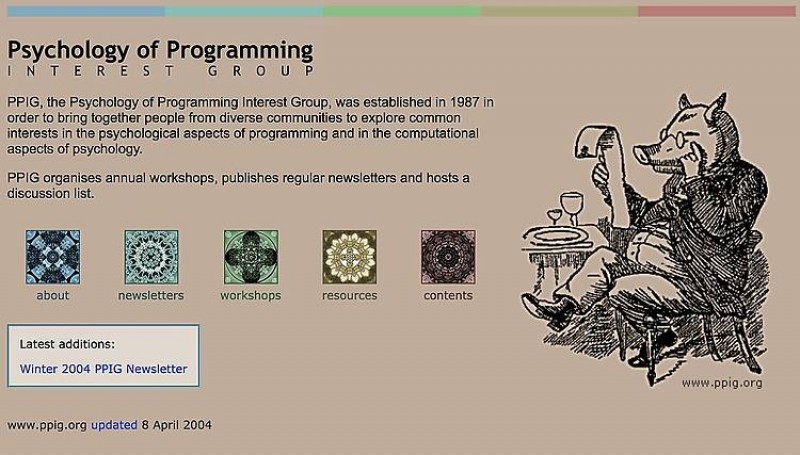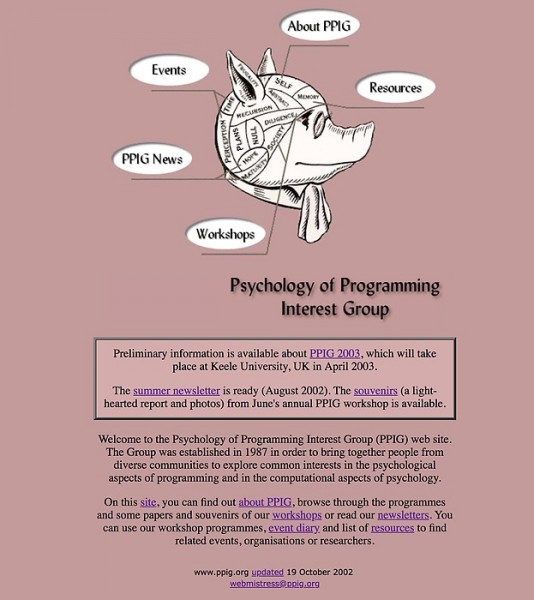PPIG web site
PPIG organises annual workshops; its web site supports existing members by publishing workshop details whilst encouraging new members with PDF versions of workshop papers, and photographic workshop reports.
PPIG is a friendly and informal group with members from all over the world. Its annual workshops have taken place in France, Belgium and Italy as well as around the UK.
Paola has been responsible for the web site of the Psychology of Programming Interest Group (PPIG) since 1995 - from 1995-2002 and 2015-2019.
During that time, the site went through three redesigns and documented PPIG's annual workshops.
First redesign (1996)
The site was redesigned in 1996 to make use of the latest HTML standard, such as the addition of background colours.
Pages used a pinkish-brown background. The home page featured a pig's head in the style of a phrenology diagram, page headings were implemented as graphics with different shapes and the site navigation was in the page footers.
Second redesign (2002)
Paola redesigned the site again at the end of 2002 before handing it over to the new maintainer:
- she assigned each site section a unique colour and shape — these have been applied to buttons, decorative section graphics, breadcrumbs, text and background colours
- the entire site was put through tidy to aid the conversion from the old HTML to CSS styles
- she then moved styles to external stylesheets for screen and print, as well as an additional stylesheet that Netscape 4.7+ would ignore
- the print stylesheet was written to hide navigation elements only needed for the screen
- she moved the site navigation to the top of pages
- a link to the home page was added to the new navigation panel in the form of the PPIG logo
- all functional text was taken out of graphics (such as page headings and the site name) and implemented in HTML; this allows the text to be resized and translated
- she took the main content out of tables for layout; this follows early results from limov.com's preferences page, as most people choose stretched lines (that is, text fills the available width of the browser window)
- all local navigation lists were placed on the right-hand side of pages
- she chose a light grey for the colour behind the main content — it's not a colour from the "web-safe palette", and it will shift to the lightest grey
- she created a consistent style for links to related pages and links to headings on the current page
- she added location breadcrumbs to all pages
Navigation panel
The new navigation panel included the site name in text, the section links as combined graphical button and text label, a link home and a colour-coded section graphic. In this panel and the breadcrumbs, the HTML links were in the section colour.
The mark-up style allowed the whole page to become very condensed without the need for horizontal scrolling (335 pixels). This is useful in high-resolution environments where multiple browser windows are not uncommon, and also on devices with smaller screens, such as PDAs.
Submission guidelines
Besides the public pages, the PPIG web site included a private section describing guidelines for people who want to submit material to the site.
Maintenance manual
Paola also provided an illustrated manual for the new maintainer in web form. It covered topics such as the house style, mark-up conventions, stylesheets, button states and graphics.
Third redesign (2015)
I redesigned and rebuilt the the web site for the Psychology of Programming Interest Group with the content management system, Drupal.
I copied over 25 years of content into new content types. I split decades of newsletters into sections and indexing them to maximise findability. I also added new sections, such as an event diary and a searchable bibliography. The site is the world's leading resource for the psychology of programming.
Mailing lists
The two PPIG mailing lists, announce and discuss, have been active since 1996. Paola administers and moderates both of them.


